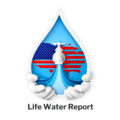Contaminants found in drinking water, Each year, 30,000 pounds of industrial chemicals are produced for each person in the United States.
Compare this to the fact that a BIG bus weighs about 30,000 pounds. These chemicals are in your drinking and bathing water. In your food. In the air you breathe. In the clothing you wear. In your skincare products. In your laundry detergent. In the products, you clean your house with. Everywhere!
Worse yet, most of these chemicals are manufactured and distributed by greedy CEOs and companies who could care less about your health! Almost none of these chemicals have been tested to determine how they affect your health. It is important to remember that the FDA and the EPA have been accused of ignoring these chemical threats to our health.
Water contains toxic chemicals such as lead, arsenic, mercury, and other heavy metals. Agricultural runoff, industrial waste, and sewage all cause these chemicals to leach into water sources. Furthermore, chlorine and fluoride, which are added to water for disinfection purposes, are toxic when ingested over time.
The EPA regulates only 90 contaminants in drinking water, out of the possible 86,153 that can be in our water. The water we consume is like a potluck dinner, where everyone brings an ingredient, but we don’t know if it’s safe to eat until the EPA evaluates it for us, and then we are still not certain. And since the overwhelming majority of these 86,153 active and inactive chemicals have “no legal limit”, then we must do our own research and figure out how to filter them out of our drinking water and protect our Family’s health.

So the question arises:
What’s in your water? Which contaminants are present in your water and how do they affect your health?
As the first major U.S. law to address water pollution, the Federal Water Pollution Control Act of 1948 was amended into the Clean Water Act in 1972.
How are contaminants defined?
As defined by the Safe Drinking Water Act, a “contaminant” is any physical, chemical, biological, or radiological substance or matter in water. Therefore, the law defines “contaminant” very broadly to include anything other than water molecules.
What causes water to become contaminated?
It’s possible for germs and chemicals to get into drinking water at the source or in the distribution system after it’s been treated. Germs and chemicals can get into water from a lot of places, like:
- A fertilizer, pesticide, or other chemical that has been applied to land near a body of water
- Large industrial animal farms with concentrated feeding operations
- Operations in the manufacturing industry
- Overflowing sewers
- Streams and rivers
- Biological diversity
- A rock or soil that naturally contains chemicals and minerals such as arsenic, radon, or uranium
- Problems with the distribution system, such as cracks in water pipes

Germs that contaminate tap water?
Common germs that contaminate water include bacteria, viruses, and parasites such as
- E. coli,
- salmonella,
- Norovirus,
- Giardia
- Rotavirus
- Shigella
- Hepatitis A virus
These germs can cause a range of illnesses, from mild gastrointestinal upsets to life-threatening diseases.
Some germs and chemicals are tested for and addressed in drinking water systems by the EPA. Utility companies are required to inform customers if they find any unsafe levels of chemicals or germs in the water during testing. Violation notices and drinking water advisories are sent to customers. The Consumer Confidence Report is also provided by water utilities to their customers every year.
Don’t trust what the EPA tells you! Go to www.LifeWaterReport.com and find out what’s really in your water! Then review your options on how to remove these toxic chemicals from your Family’s water.
References:
- ACC (American Chemistry Council). U.S. chemical production expanded in December: 2013 and ended on a high note. 2014. [March 30, 2014]. http://www.americanchemistry.com/Media/PressReleasesTranscripts/ACC-news-releases/US-Chemical-Production-Expanded-in-December-2013-Ends-on-a-High-Note.html.
- EPA (U.S. Environmental Protection Agency). TSCA chemical substance inventory: Basic information. 2014. [March 30, 2014]. http://www.epa.gov/oppt/existingchemicals/pubs/tscainventory/basic.html.
- GAO (U.S. Government Accountability Office). Toxic substances: EPA has increased efforts to assess and control chemicals but could strengthen its approach. Washington, DC: GAO; 2013.
- Goldman LR. Chapter 17: Toxic chemicals and pesticides. Dernbach JC, editor. Washington, DC: Environmental Law Institute; 2002. (Stumbling toward sustainability).
- Halperin WE. Public Health Approach to Industrial Chemical Assessments: 5 Paradigms. Washington, DC: 2013. (Presentation at the Institute of Medicine Workshop on the Identifying and Reducing Environmental Health Risks of Chemicals in Our Society).
- IOM (Institute of Medicine). Care without coverage: Too little, too late. Washington, DC: National Academy Press; 2002. [PubMed]
- IOM. Hidden cost, value lost: Uninsurance in America. Washington, DC: The National Academies Press; 2003. [PubMed]
- National Conversation on Public Health and Chemical Exposures. Addressing public health and chemical exposures: An action agenda. Atlanta, GA: Centers for Disease Control and Prevention, Agency for Toxic Substances and Disease Registry; 2011.
- NRC (National Research Council). Risk assessment in the federal government: Managing the process. Washington, DC: National Academy Press; 1983. [PubMed]
- NRC. Science and decisions: Advancing risk assessment. Washington, DC: The National Academies Press; 2009. [PubMed]
- Paracelsus. Preface to the Coelum Philosophorum. 1531.
- Rose G. The strategy of preventive medicine. Oxford: Oxford University Press; 1992.
- Safer Chemicals Healthy Families. Chemicals and our health: Why recent science is a call to action. 2012. [March 30, 2014]. http://saferchemicals.org/PDF/chemicals-and-our-health-july-2012.pdf.
- SOCMA (Society of Chemical Manufacturers and Affiliates). Myth versus fact about chemicals in commerce. 2014. [March 30, 2014]. http://www.socma.com/GovernmentRelations/index.cfm?subSec=26&articleID=3259.
- UNEP (United Nations Environment Programme). Global chemicals outlook: Towards sound management of chemicals. Geneva: UNEP; 2013.
- Ward E, DeSantis C, Robbins A, Kohler B, Jemal A. Childhood and adolescent cancer statistics, 2014. CA Cancer Journal for Clinicians. 2014;64(2):83–103. [PubMed]
- Wilson MP, Schwarzman MR, Malloy TF, Fanning EW, Sinsheimer PJ. Green chemistry: Cornerstone to a sustainable California. Berkley, CA: Centers for Occupational and Environmental Health, University of California; 2008.
